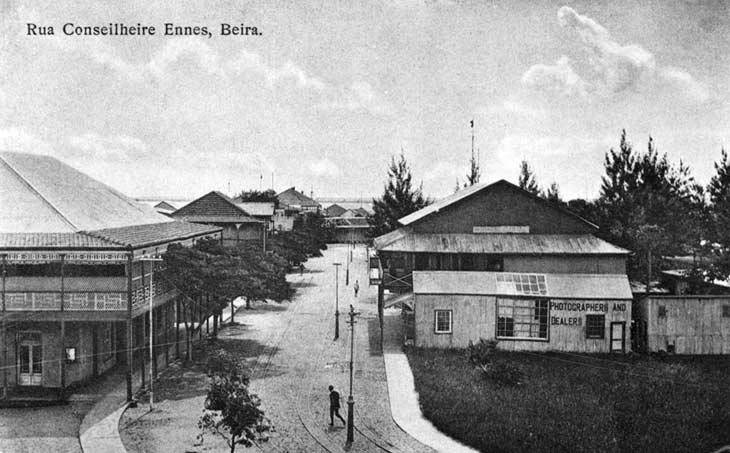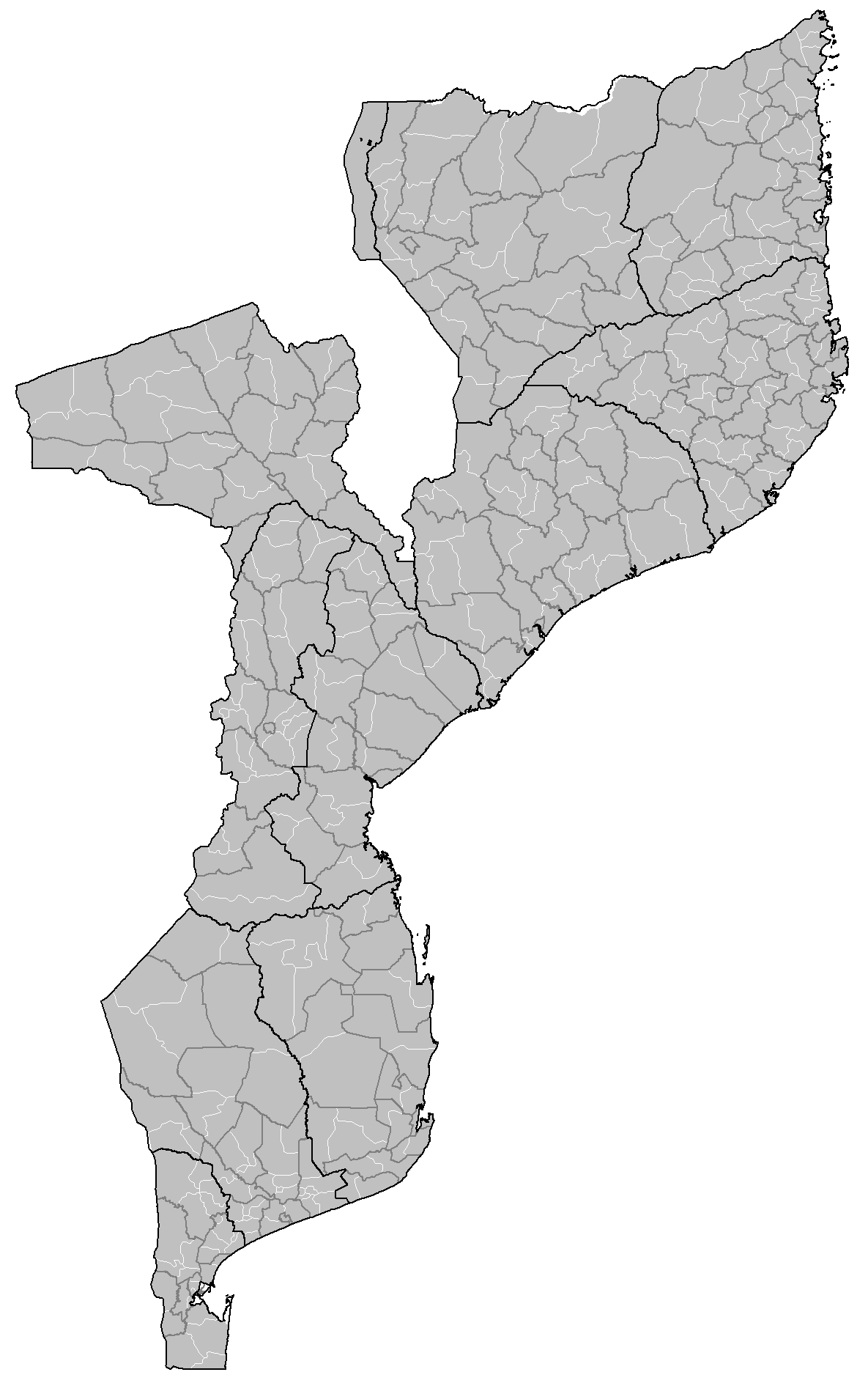|
Gondola District
Gondola District is a district of Manica Province in western Mozambique. The principal town is Gondola. The area of the district is . It has a population of 262,412 as of 2007. Geography The district is located in the east of the province, and borders with Gorongosa District of Sofala Province to the northeast, Nhamatanda District of Sofala Province to the east, Buzi District of Sofala Province to the southeast, Macate District to the south and southwest, Chimoio District to the west, and Vanduzi District to the northwest. The main river in the district is the Pungwe River, which makes the border with Gorongosa District. The climate of the district varies with altitude. The lowlands are characterized by relatively low rainfall, between and . The transition zone has the average rainfall , and in higher altitude plains it varies between and . History The settlement of Gondola was developed as a station on a railroad connecting Beira and Salisbury. Demographics As of 2005, ... [...More Info...] [...Related Items...] OR: [Wikipedia] [Google] [Baidu] |
Districts Of Mozambique
The provinces of Mozambique are divided into 128 districts. The districts are listed below, by province: Cabo Delgado Province *Ancuabe District *Balama District *Chiúre District *Ibo, Mozambique, Ibo District *Macomia District *Mecúfi District *Meluco District *Mocímboa da Praia District *Montepuez District *Mueda District *Muidumbe District *Namuno District *Nangade District *Palma, Mozambique, Palma District *Pemba-Metuge District *Quissanga District Gaza Province *Bilene Macia District *Chibuto District *Chicualacuala District *Chigubo District *Chókwè District *Guijá District *Mabalane District *Manjacaze District *Massangena District *Massingir District *Xai-Xai District Inhambane Province *Funhalouro District *Govuro District *Homoine District *Inharrime District *Inhassoro District *Jangamo District *Mabote District *Massinga District *Morrumbene District *Panda District *Vilanculos District *Zavala District Manica Province *Báruè District *Gondola Distric ... [...More Info...] [...Related Items...] OR: [Wikipedia] [Google] [Baidu] |
Beira, Mozambique
Beira is the capital and largest city of Sofala Province, where the Pungwe River meets the Indian Ocean, in the central region of Mozambique. It is the fourth-largest city by population in Mozambique, after Maputo, Matola and Nampula. Beira had a population of 397,368 in 1997, which grew to 530,604 in 2019. A coastal city, it holds the regionally significant Port of Beira, which acts as a gateway for both the central interior portion of the country as well as the land-locked nations of Zimbabwe, Zambia and Malawi. Originally called Chiveve after a local river, it was renamed Beira to honour the Portuguese Crown prince Dom Luís Filipe (titled Prince of Beira, itself referring to the traditional Portuguese province of Beira), who had visited Mozambique in the early 1900s. It was first developed by the Portuguese Mozambique Company in the 19th century, supplanting Sofala as the country's main port. It was then directly developed by the Portuguese colonial government ... [...More Info...] [...Related Items...] OR: [Wikipedia] [Google] [Baidu] |
Zimbabwe
Zimbabwe (), officially the Republic of Zimbabwe, is a landlocked country located in Southeast Africa, between the Zambezi and Limpopo Rivers, bordered by South Africa to the south, Botswana to the south-west, Zambia to the north, and Mozambique to the east. The capital and largest city is Harare. The second largest city is Bulawayo. A country of roughly 15 million people, Zimbabwe has 16 official languages, with English, Shona language, Shona, and Northern Ndebele language, Ndebele the most common. Beginning in the 9th century, during its late Iron Age, the Bantu peoples, Bantu people (who would become the ethnic Shona people, Shona) built the city-state of Great Zimbabwe which became one of the major African trade centres by the 11th century, controlling the gold, ivory and copper trades with the Swahili coast, which were connected to Arab and Indian states. By the mid 15th century, the city-state had been abandoned. From there, the Kingdom of Zimbabwe was established, fol ... [...More Info...] [...Related Items...] OR: [Wikipedia] [Google] [Baidu] |
Sorghum
''Sorghum'' () is a genus of about 25 species of flowering plants in the grass family ( Poaceae). Some of these species are grown as cereals for human consumption and some in pastures for animals. One species is grown for grain, while many others are used as fodder plants, either cultivated in warm climates worldwide or naturalized in pasture lands. Taxonomy ''Sorghum'' is in the Poaceae (grass) subfamily Panicoideae and the tribe Andropogoneae (the same as maize, big bluestem and sugarcane). Species Accepted species recorded include: Distribution and habitat Seventeen of the 25 species are native to Australia, with the range of some extending to Africa, Asia, Mesoamerica, and certain islands in the Indian and Pacific Oceans. Toxicity In the early stages of the plants' growth, some species of sorghum can contain levels of hydrogen cyanide, hordenine, and nitrates, which are lethal to grazing animals. Plants stressed by drought or heat can also contain ... [...More Info...] [...Related Items...] OR: [Wikipedia] [Google] [Baidu] |
Cowpea
The cowpea (''Vigna unguiculata'') is an annual herbaceous legume from the genus '' Vigna''. Its tolerance for sandy soil and low rainfall have made it an important crop in the semiarid regions across Africa and Asia. It requires very few inputs, as the plant's root nodules are able to fix atmospheric nitrogen, making it a valuable crop for resource-poor farmers and well-suited to intercropping with other crops. The whole plant is used as forage for animals, with its use as cattle feed likely responsible for its name. Four subspecies of cowpeas are recognised, of which three are cultivated. A high level of morphological diversity is found within the species with large variations in the size, shape, and structure of the plant. Cowpeas can be erect, semierect (trailing), or climbing. The crop is mainly grown for its seeds, which are high in protein, although the leaves and immature seed pods can also be consumed. Cowpeas were domesticated in Africa and are one of the o ... [...More Info...] [...Related Items...] OR: [Wikipedia] [Google] [Baidu] |
Cassava
''Manihot esculenta'', commonly called cassava (), manioc, or yuca (among numerous regional names), is a woody shrub of the spurge family, Euphorbiaceae, native to South America. Although a perennial plant, cassava is extensively cultivated as an annual crop in tropical and subtropical regions for its edible starchy tuberous root, a major source of carbohydrates. Though it is often called ''yuca'' in parts of Spanish America and in the United States, it is not related to yucca, a shrub in the family Asparagaceae. Cassava is predominantly consumed in boiled form, but substantial quantities are used to extract cassava starch, called tapioca, which is used for food, animal feed, and industrial purposes. The Brazilian farinha, and the related ''garri'' of West Africa, is an edible coarse flour obtained by grating cassava roots, pressing moisture off the obtained grated pulp, and finally drying it (and roasting both in the case of farinha and garri). Cassava is the third-largest so ... [...More Info...] [...Related Items...] OR: [Wikipedia] [Google] [Baidu] |
Postos Of Mozambique
The districts of Mozambique are divided into 405 ''postos''. ''Postos administrativos'' (administrative posts) are the main subdivisions of districts A district is a type of administrative division that, in some countries, is managed by the local government. Across the world, areas known as "districts" vary greatly in size, spanning regions or county, counties, several municipality, municipa .... This name, in use during colonial times, was abolished after independence, and was replaced by ''localidades'' (localities). However, it was re-established in 1986.Lei nº 4/86 de 25 de Julho. Administrative posts are headed by a ''Secretário'' (secretary), which before independence were called ''Chefes de Posto'' (post chief). Administrative posts can be further subdivided into localities, also headed by secretaries. Notes ''This article includes content from the Portuguese Wikipedia article Posto administrativo.'' See also * List of postos of Mozambique References Sub ... [...More Info...] [...Related Items...] OR: [Wikipedia] [Google] [Baidu] |
Portuguese Language
Portuguese ( or, in full, ) is a western Romance language of the Indo-European language family, originating in the Iberian Peninsula of Europe. It is an official language of Portugal, Brazil, Cape Verde, Angola, Mozambique, Guinea-Bissau and São Tomé and Príncipe, while having co-official language status in East Timor, Equatorial Guinea, and Macau. A Portuguese-speaking person or nation is referred to as "Lusophone" (). As the result of expansion during colonial times, a cultural presence of Portuguese speakers is also found around the world. Portuguese is part of the Ibero-Romance group that evolved from several dialects of Vulgar Latin in the medieval Kingdom of Galicia and the County of Portugal, and has kept some Celtic phonology in its lexicon. With approximately 250 million native speakers and 24 million L2 (second language) speakers, Portuguese has approximately 274 million total speakers. It is usually listed as the sixth-most spoken language, the third-mos ... [...More Info...] [...Related Items...] OR: [Wikipedia] [Google] [Baidu] |



